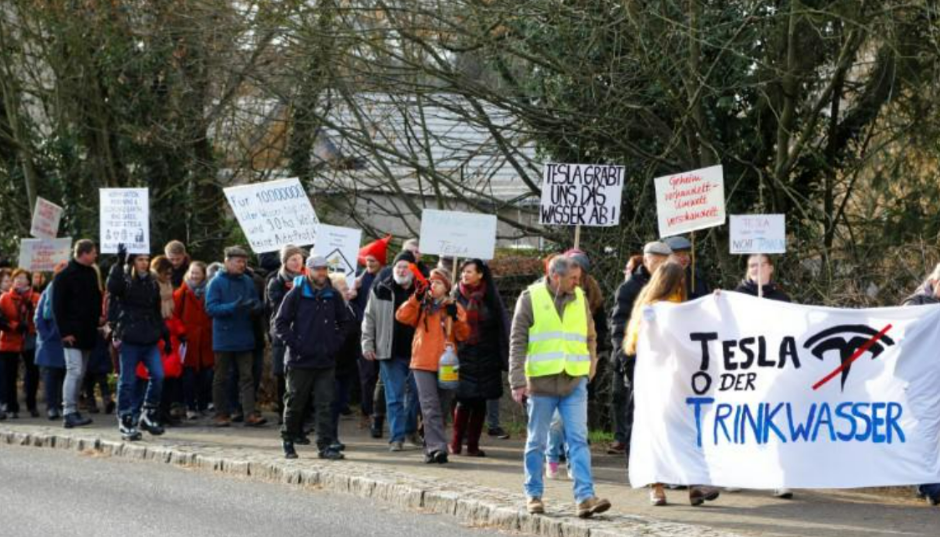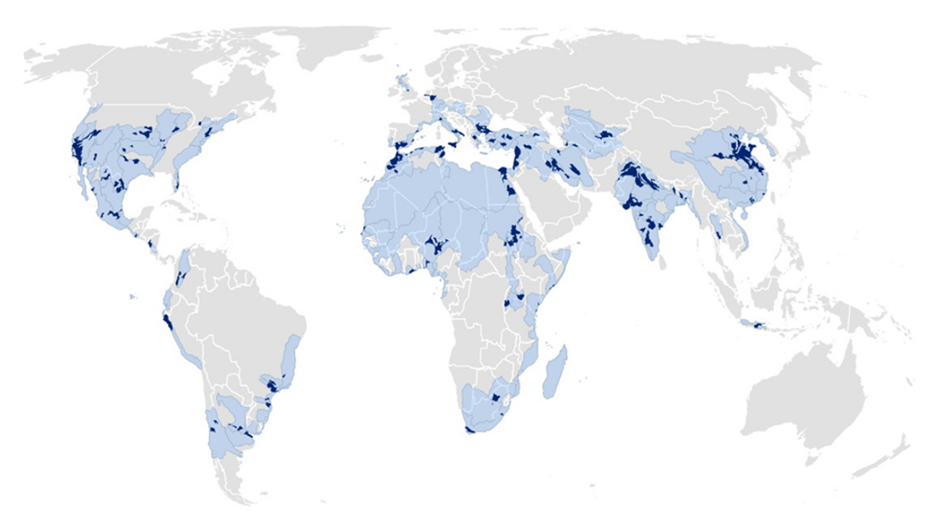With the threat of a global water shortage looming, businesses are increasingly taking action to increase water efficiency and reuse, reduce consumption and protect water quality. But improvements to internal production processes and operations can only go so far. In this article, we explore the growing shift toward collective action, and how businesses – and the communities in which they operate – can best realize the shared benefits.
In September, it was reported that carmaker Tesla would help drill water wells near its planned gigafactory near Monterrey, Mexico. The move was seen as an effort to quell opposition from environmentalists and local officials over water use in an already water-stressed area. According to news reports, Tesla also obtained permits to use treated wastewater in its electric vehicle production.

Demonstrators hold anti-Tesla posters during a protest plans by Tesla to build its first European factory and design center in Gruenheide near Berlin, Germany January 18, 2020. REUTERS/Pawel Kopczynski
It’s not the first time the company has found itself being forced into action on water. The first phase of construction for its production factory in Brandenburg, Germany was delayed due to environmental concerns, and this year, the company tried to get ahead of criticism, announcing that its plans to double production at the plant would not require additional fresh water.
It’s the latest example of how water is upping the ante for business leaders and creating complex – and operationally significant – risks. At the current pace of industrial activity, the world will already face a 53% shortfall in global water supply by 2050. Climate change is only exacerbating the situation – making weather patterns less predictable and increasing the frequency and intensity of floods and droughts.
As we see with Tesla, for businesses, these changes manifest as higher water-related challenges, including water availability, water quality (e.g. pollution), exposure to floods and droughts, and reputational, regulatory, and financial risks.
Forward-looking businesses have taken steps to improve water efficiency, reduce water consumption in production processes, and control effluent discharges on-site, but the water challenges cannot be solved in isolation.
There is a growing need to view and manage water as a shared resource – beyond the operational ‘fence’ and down to the water catchment level – and to collaborate with stakeholders, including private companies, public sector, and civil society, to address water security, support the regeneration of water resources, and promote biodiversity.
Collaboration with stakeholders for catchment-based actions can generate real business benefits.
First and foremost, collaboration mitigates operational risks, such as preventing project delays and the cancellations of licenses, protecting resources the businesses need to ensure a consistent and good quality water supply, and building resilience to water-related shocks. It also brings intangible benefits in terms of strengthening the reputation and perception of the company by better aligning its actions with the needs of the community.
A company can also leverage outside-the-fence actions to drive innovation, and importantly, to achieve its commitments and ESG goals. Ultimately, collaborative action ensures companies retain their license to operate and hence, supports business growth and resilience.
Outside-the-fence collaboration is a spectrum; ranging from working directly with an NGO on a specific project to more complex collective action in which several companies collaborate to maximize their resources or impact. Regardless of the specific approach, collaborative action must be contextualized, genuine, and transparent in order to maximize its impact and benefits.
The (water) context is key
The starting point of any collaborative action should be to focus on understanding and addressing the needs and risks of the specific water basin in which the business operates or relies – as opposed to seeking to solve an internal business or operational challenge. For many leaders, this means deliberately shifting from a company centric perspective to one that is basin or system centric.
“A basin or system-centric approach focuses on how the company can best contribute to the overall water health of a location in which it operates. A company that does not take this approach runs the risk of an intervention being directed at a problem that isn’t that important in a specific location and coming across as being disconnected from what’s really needed,” says Paul Fleming, President, WaterValue.
Fleming formerly served as Global Water Program Manager at Microsoft, where he helped establish the company’s goal to be water positive by 2030. There, he led investments in nearly 20 access and replenishment projects, including partnering with the Edwards Aquifer Authority to support efforts to acquire conservation easements to keep land from being developed to ensure groundwater recharge.
Taking a basin-centric approach does not mean projects serve no direct benefit to the businesses that lead them. Freeport McMoRan, a mining company with operations in water-scarce regions, wanted to improve the water quantity and quality near its Cerro Verde mine, located near the city of Arequipa, Peru. The city had no wastewater treatment solution and raw sewage was discharged straight into the Chili River.
The company worked with the local utility and invested $500 million to build the city’s first wastewater treatment plant. The plant helped improve local water quality, enhanced agricultural production, and reduced the risk of waterborne diseases, thus supporting the health of its local workforce. At the same time, the company secured water for its mine expansion by using part of the treated effluent for its water supplies.
Data-driven transparency
Understanding which actions will be the most relevant and meaningful requires data. Specifically, an assessment should be conducted to clearly scope and justify what impact a business could achieve through collaborative action and what kind of collaborative action best aligns with its goals – as well as to identify the right stakeholders to involve in such an initiative.
With a data-driven approach, water stewardship objectives become reportable, and a transparent dialogue is created with company employees, communities, and potential collaborators – ultimately making projects more easily implementable, scalable, and replicable.
For example, beverage company Diageo had implemented a Water, Sanitation, and Hygiene (WASH) program that was initially limited in scope – driven by a desire to differentiate their brand and motivate employees through philanthropy efforts in Africa. It then undertook a comprehensive risk assessment of its sites to better understand its specific water risks, operational and supply chain needs, and the outcomes from its WASH previous projects.
Through that process, the company identified significant operational and business opportunities – beyond ‘feel good’ philanthropic benefits. It began investing in farming businesses and communities close to its operations to support the health, productivity, and sustainability of these communities – ultimately gaining the trust of key stakeholders and governments and improving their own supply chain resilience.
Water solution providers are positioned slightly differently, with an additional opportunity to leverage their own expertise towards collaborative action and water stewardship. Recognizing that robust data is needed to inform the impactful actions, Ecolab developed the Smart Water Navigator – a platform designed to support companies in identifying and quantifying risks and challenges at a local level. To further encourage businesses to better identify water risks and track efforts, Ecolab made the platform free to use.
By positioning itself as an enabler in water stewardship, Ecolab not only promotes transparent, data-driven, collective action for businesses but also creates opportunity to innovate and sell their expertise across the full life cycle of a company’s water stewardship journey – offering access to technologies for water optimization and management.
Genuine stakeholder engagement and collaboration
In today’s complex business landscape, aligning stakeholders on objectives, responsibilities, and desired outcomes is not just a best practice; it’s an imperative. This is particularly true when it comes to water; a shared resource that transcends corporate boundaries and jurisdictions.
For businesses seeking to improve their water stewardship, it means identifying like-minded companies that share similar operational and geographical interests and commitments related to water access and water quality. These shared interests foster a sense of common purpose and create opportunities to leverage the strengths of each partner or collaborator.
For example, teaming up with a partner that can better facilitate interactions with local governments and community stakeholders can support a ‘bottom-up’ approach that can ensure that solutions are contextually relevant while also enhancing the project’s impact.
Coalitions and collaboratives play a pivotal role in uniting like-minded organizations with the right tools and resources. These collaborative platforms bring together a diverse array of stakeholders, including corporations, non-governmental organizations (NGOs), and public entities to collectively tackle water-related issues.
Coalitions can serve as vehicles for shared learning, knowledge exchange, and mobilizing resources – as well as helping ensure local voices are not only heard but are positioned as key drivers across initiatives.
The Water Risk Coalition (WRC) and Alliance for Water Stewardship are just two examples of an industry-driven coalitions to deliver a water resilient future.

The Water Risk Coalition’s 100 priority basins, selected in collaboration with Alliance for Water Stewardship, CEO Water Mandate, Good Stuff International, The Nature Conservancy, Pacific Institute, WRAP, WWF. Map Image Credit: WWF
Collaborative, outside the fence action can only be truly impactful if it is contextualized to specific water needs, developed, measured and/or reported on in a transparent way, and based on genuine stakeholder alignment. Setting clear and measurable goals lays the foundation productive engagement and unlocks opportunities to truly understand the basin context and build trust with local and international stakeholders. With measurable targets, companies can more easily replicate and scale projects – and provide a strong case by which it can attract additional capital and support.
